AeroSafe Case Study: Critical Theories of Organizational HRM
VerifiedAdded on 2023/02/06
|14
|4299
|97
Report
AI Summary
This report examines the HRM practices of AeroSafe, an aircraft company operating in multiple countries, and identifies critical challenges in diversity management, organizational culture, international performance management, and training and development. The analysis highlights issues such as intolerance towards diverse age groups, weak organizational culture due to communication breakdowns, lack of international performance review mechanisms, and insufficient training programs. The report applies relevant HRM theories to evaluate AeroSafe's performance, including the cognitive diversity hypothesis, similarity-attraction model, goal-setting theory, and expectancy theory. It concludes with recommendations for improving HR practices to enhance organizational capabilities, foster a positive culture, implement performance management systems, and provide effective training programs to address the company's product quality issues and overall performance.
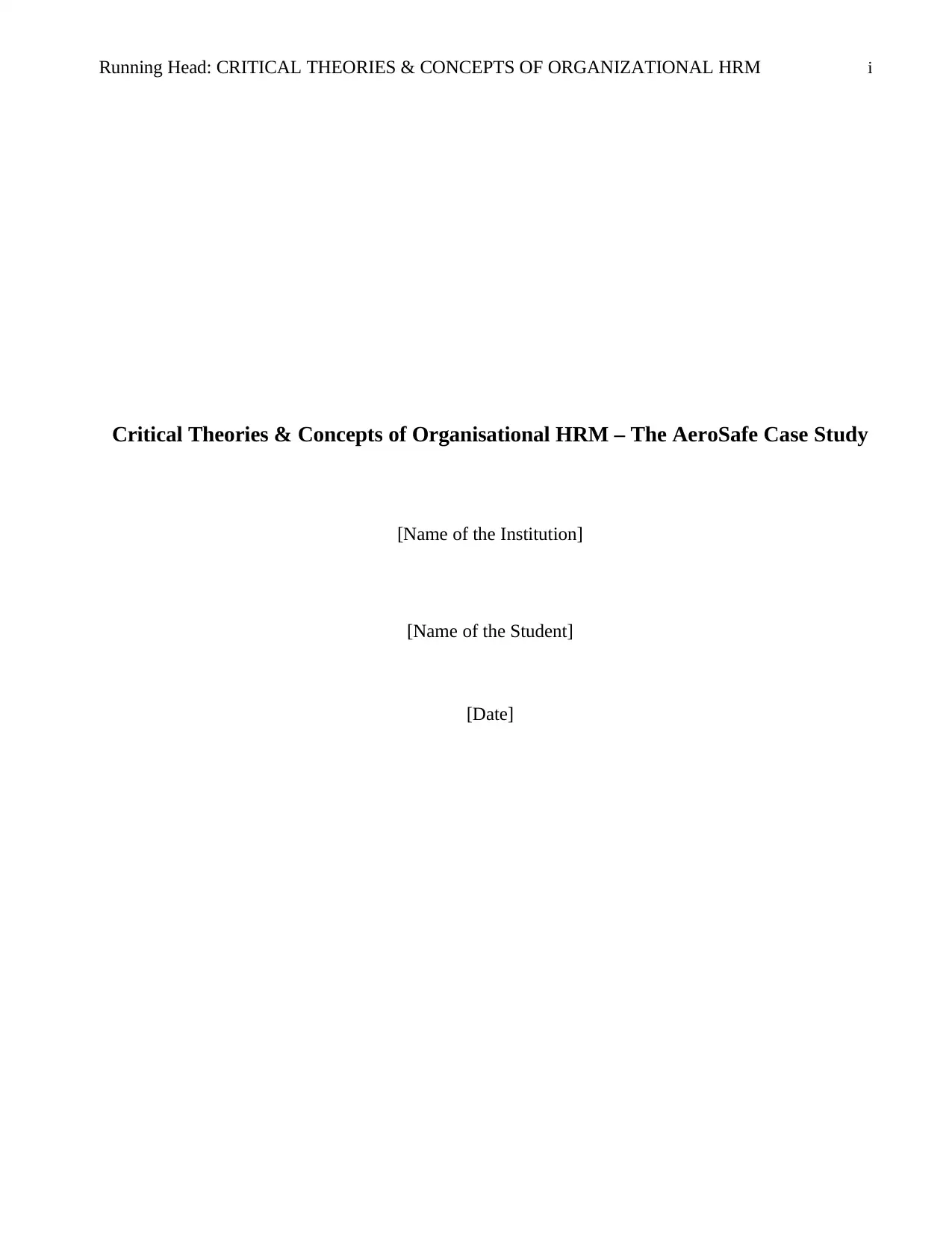
Running Head: CRITICAL THEORIES & CONCEPTS OF ORGANIZATIONAL HRM i
Critical Theories & Concepts of Organisational HRM – The AeroSafe Case Study
[Name of the Institution]
[Name of the Student]
[Date]
Critical Theories & Concepts of Organisational HRM – The AeroSafe Case Study
[Name of the Institution]
[Name of the Student]
[Date]
Paraphrase This Document
Need a fresh take? Get an instant paraphrase of this document with our AI Paraphraser
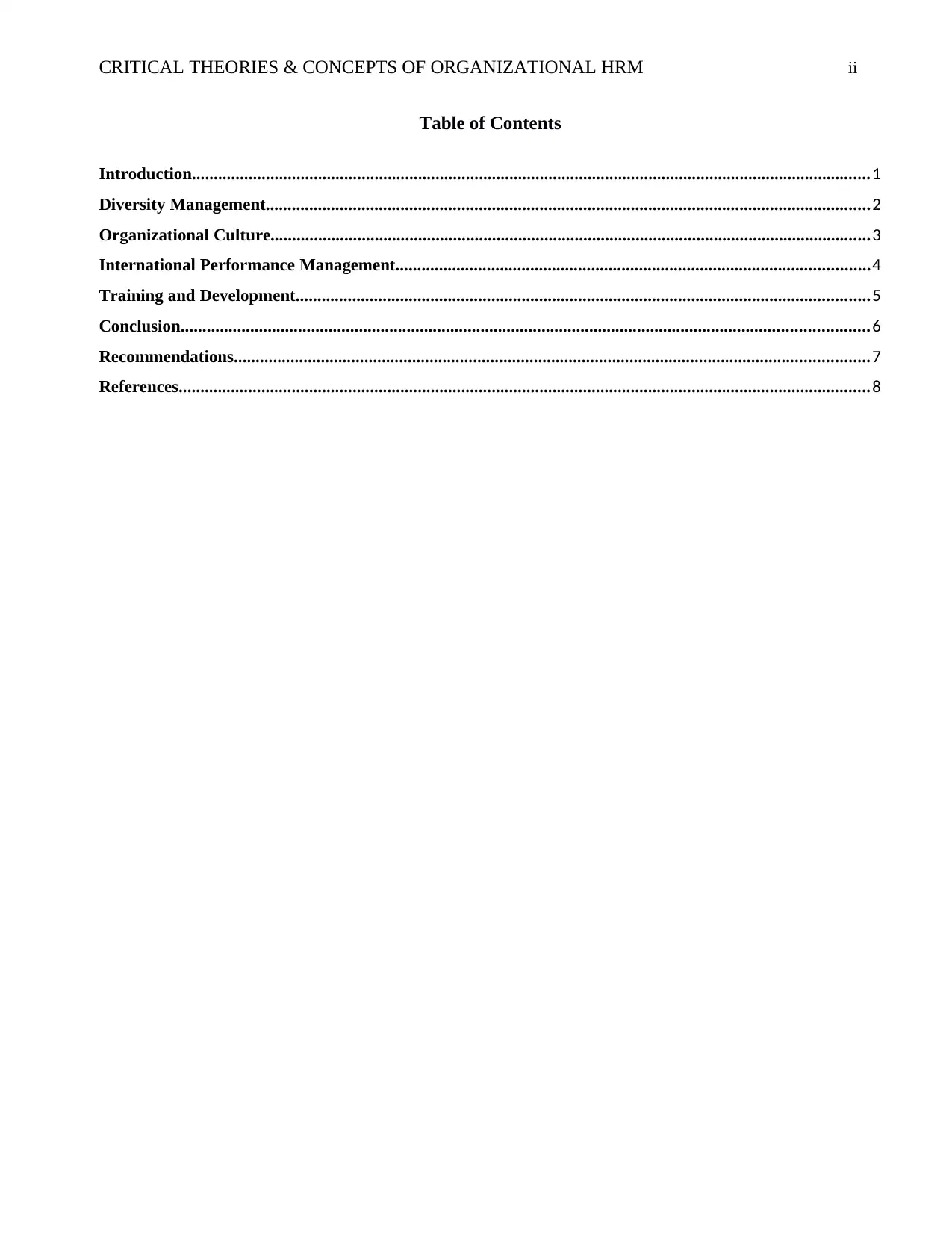
iiCRITICAL THEORIES & CONCEPTS OF ORGANIZATIONAL HRM
Table of Contents
Introduction............................................................................................................................................................1
Diversity Management...........................................................................................................................................2
Organizational Culture..........................................................................................................................................3
International Performance Management.............................................................................................................4
Training and Development....................................................................................................................................5
Conclusion..............................................................................................................................................................6
Recommendations..................................................................................................................................................7
References...............................................................................................................................................................8
Table of Contents
Introduction............................................................................................................................................................1
Diversity Management...........................................................................................................................................2
Organizational Culture..........................................................................................................................................3
International Performance Management.............................................................................................................4
Training and Development....................................................................................................................................5
Conclusion..............................................................................................................................................................6
Recommendations..................................................................................................................................................7
References...............................................................................................................................................................8

1CRITICAL THEORIES & CONCEPTS OF ORGANIZATIONAL HRM
Introduction
Numerous challenges faced by modern organizations influence their prospective to attain their
objectives. The most significant challenges for organizations today are issues related to Human
Resource Management (HRM) and its four key areas, namely Diversity Management and
Culture, International Performance Management, and Training and Development, especially
when organizations functions in different countries of the world. Therefore, HRM is one of the
essential purposeful areas of management studies that deals with people, regulate and maintained
people’s actions, focused on development of people and strive for future .Since last two decades,
human resource management is being taken as a vital function amongst all other administrative
measures. Therefore, the study of HRM is acknowledged as an essential component of
organization by many academicians and scholars because HRM increase competitive gain for an
organization. (Hassan Danial Aslam et al, 2013). Therefore HR specialists, leadership and team
like any other professional groups within an organization, take on a central role in organizational
sustainability and productivity. (Harold Schroeder, 2012). Here organizations face limitations as
each country of the world has its procedures and practices of HRM. Multi-National Companies
(MNCs) are thus facing challenges to create harmony and coordination in their HRM policies
while operating in diverse business environments and nationalities. Therefore it is essential to
analyze in depth the structural necessities for the exploitation of human resource management
towards amplified organizational outcome, and to provide a theoretical outline for the critical
examination and evaluation of human resource management in organizations. (Patricia &
Miltiadis, 2008). In the present context of globalization, HRM offer assistances to create bond
and links between employees' performance and the organization's deliberate aims. Thus, the
success of an organization is subject to deployment of the staff. Therefore, it’s vital for
organizations to hire employees who strictly adhere to their job responsibilities.
AeroSafe, an aircraft company, is based in Australia and operates in three other countries:
China, Singapore, and Vietnam. AeroSafe has potential buyers worldwide; however, the
company is facing problems in the quality of its products, although the four countries' workforce,
managerial and engineering staff are working to ensure aircraft quality. This essay aims to
evaluate the strength and weaknesses of AeroSafe's organizational performance with particular
Introduction
Numerous challenges faced by modern organizations influence their prospective to attain their
objectives. The most significant challenges for organizations today are issues related to Human
Resource Management (HRM) and its four key areas, namely Diversity Management and
Culture, International Performance Management, and Training and Development, especially
when organizations functions in different countries of the world. Therefore, HRM is one of the
essential purposeful areas of management studies that deals with people, regulate and maintained
people’s actions, focused on development of people and strive for future .Since last two decades,
human resource management is being taken as a vital function amongst all other administrative
measures. Therefore, the study of HRM is acknowledged as an essential component of
organization by many academicians and scholars because HRM increase competitive gain for an
organization. (Hassan Danial Aslam et al, 2013). Therefore HR specialists, leadership and team
like any other professional groups within an organization, take on a central role in organizational
sustainability and productivity. (Harold Schroeder, 2012). Here organizations face limitations as
each country of the world has its procedures and practices of HRM. Multi-National Companies
(MNCs) are thus facing challenges to create harmony and coordination in their HRM policies
while operating in diverse business environments and nationalities. Therefore it is essential to
analyze in depth the structural necessities for the exploitation of human resource management
towards amplified organizational outcome, and to provide a theoretical outline for the critical
examination and evaluation of human resource management in organizations. (Patricia &
Miltiadis, 2008). In the present context of globalization, HRM offer assistances to create bond
and links between employees' performance and the organization's deliberate aims. Thus, the
success of an organization is subject to deployment of the staff. Therefore, it’s vital for
organizations to hire employees who strictly adhere to their job responsibilities.
AeroSafe, an aircraft company, is based in Australia and operates in three other countries:
China, Singapore, and Vietnam. AeroSafe has potential buyers worldwide; however, the
company is facing problems in the quality of its products, although the four countries' workforce,
managerial and engineering staff are working to ensure aircraft quality. This essay aims to
evaluate the strength and weaknesses of AeroSafe's organizational performance with particular
⊘ This is a preview!⊘
Do you want full access?
Subscribe today to unlock all pages.

Trusted by 1+ million students worldwide

2CRITICAL THEORIES & CONCEPTS OF ORGANIZATIONAL HRM
reference to its HRM. The critical areas of HRM associated with the issues faced by AeroSafe
will be evaluated, and recommendations will be given for future improvement.
Diversity Management
With the increase globalization there is demographical diversity of the workforce,
handling diversity in companies is an essential administrative function (Olsen & Martins, 2012).
The variety of a force is a identifiable source of originality and improvement that can provide a
competitive advantage. Still, on the other hand, it also causes misinterpretation, doubt, and give
rise to conflicts in the workplace that can result in malingering, low quality, low motivation, and
loss of effectiveness. This is why management of diversity in organizations is measured as one of
the critical challenges for HRM in modern-day organizations.
Many theories are addressing the matter of how to manage the diverse workforce while
maximizing employees’ responses and performance. The cognitive diversity hypothesis
proposes that numerous insights stemming from the cultural variances between group or
organizational members result in creative problem solving and innovation (Chow, 2018).
According to this theory, creating heterogeneous teams looks to be an effective strategy, but, in
reality, the heterogeneous teams face some unique and different challenges. They sometimes
may result in lower performance levels (Mansoor, Ali, Ali & Ali, 2013). Likewise, the
similarity- attraction model and social identity theory provide that employees’ inclinations
for cooperating with others like themselves could result in variety, thus compromise on group
and organizational results. There is a proportion of diversity that arises from an organization. As
per empirical studies of diversity management by Magoshi and Chang (2009), diversity is visible
in matters connecting to each individual like nationality, society background, gender, age, or
physical and psychological potentials. While Lestari (2015), with almost the same language,
stated some features of organizational diversity. These characteristics will include age, ethnicity,
gender, ability, race. Topography, efforts, experience, salary, religion, language, coordination
and social connections, and qualification are some more areas that are associated with diversity
management (Bakhri, Udin, Daryono, & Suharnomo, 2018). This diversity requires substantial
complex management, mainly when diversity issues deal with human resource management
issues such as reward, raise, training, management control, and other matters within the
reference to its HRM. The critical areas of HRM associated with the issues faced by AeroSafe
will be evaluated, and recommendations will be given for future improvement.
Diversity Management
With the increase globalization there is demographical diversity of the workforce,
handling diversity in companies is an essential administrative function (Olsen & Martins, 2012).
The variety of a force is a identifiable source of originality and improvement that can provide a
competitive advantage. Still, on the other hand, it also causes misinterpretation, doubt, and give
rise to conflicts in the workplace that can result in malingering, low quality, low motivation, and
loss of effectiveness. This is why management of diversity in organizations is measured as one of
the critical challenges for HRM in modern-day organizations.
Many theories are addressing the matter of how to manage the diverse workforce while
maximizing employees’ responses and performance. The cognitive diversity hypothesis
proposes that numerous insights stemming from the cultural variances between group or
organizational members result in creative problem solving and innovation (Chow, 2018).
According to this theory, creating heterogeneous teams looks to be an effective strategy, but, in
reality, the heterogeneous teams face some unique and different challenges. They sometimes
may result in lower performance levels (Mansoor, Ali, Ali & Ali, 2013). Likewise, the
similarity- attraction model and social identity theory provide that employees’ inclinations
for cooperating with others like themselves could result in variety, thus compromise on group
and organizational results. There is a proportion of diversity that arises from an organization. As
per empirical studies of diversity management by Magoshi and Chang (2009), diversity is visible
in matters connecting to each individual like nationality, society background, gender, age, or
physical and psychological potentials. While Lestari (2015), with almost the same language,
stated some features of organizational diversity. These characteristics will include age, ethnicity,
gender, ability, race. Topography, efforts, experience, salary, religion, language, coordination
and social connections, and qualification are some more areas that are associated with diversity
management (Bakhri, Udin, Daryono, & Suharnomo, 2018). This diversity requires substantial
complex management, mainly when diversity issues deal with human resource management
issues such as reward, raise, training, management control, and other matters within the
Paraphrase This Document
Need a fresh take? Get an instant paraphrase of this document with our AI Paraphraser

3CRITICAL THEORIES & CONCEPTS OF ORGANIZATIONAL HRM
organization. It is also witnessed in many case studies that diversity management practices
prompt positive effects on employees' organizational commitment (Magoshi and Chang-2009).
The case study of AeroSafe indicates complications related to diversity management in
the company. The intolerance towards working with employees from different age groups
emerged as a serious matter. As a result, working relationships strained that badly affected the
company's productivity. There is a lack of HR practices and procedures to motivate and train
employees to perceive and manage diversity in the workplace. Also, discriminatory recruitment
practices are observed in the company, especially aspirants with disabilities who are unwelcome.
With the help of HR intervention in diversity management, AeroSafe's organizational
capabilities and competency can be improved.
Organizational Culture
For many researchers, managing culture within the organization is still an exciting
discussion. This fact is established by many studies related to organizational culture and its
consequences (Tsai, 2011; Acar, 2012; Yesil and Kaya, 2013; Iljins, Skvarciany & Gaile-Sarkane,
2015; Lee, Shiue et al., 2016). MNCs face cultural differences in the era of a global economy
and liberal markets as they operate in different countries worldwide. Each country is unique in its
approaches, and culture prevails in the workplace. Thus, the organizational culture significantly
affects many facets, such as teamwork, company purposes, policymaking, and employee
productivity in challenging tasks.
In the field of HRM, the concept of organizational culture is very manifold. Goldberg,
Riordan, and Schaffer (2010) mention that organizational culture is a system of collective
meanings shared by members to make organization distinct from another. On other hand,
according to Sinding and Waldstrom (2014), organizational culture is a set of shared, understood
expectations held by the team, defining perceptions, thoughts, and reactions to various
environments. In short, organizational culture shapes the organization's socialization activities,
language, symbols, and ceremonies. Thus, a solid corporate culture helps the company to attain
its goals and improve its competency.
The development of positive organizational culture is one of the significant
responsibilities of HR leadership and the HR team. (Liao; Chang et al 2012) They can attain this
goal by establishing strong and clear communication channels, reinforcing organizational values,
organization. It is also witnessed in many case studies that diversity management practices
prompt positive effects on employees' organizational commitment (Magoshi and Chang-2009).
The case study of AeroSafe indicates complications related to diversity management in
the company. The intolerance towards working with employees from different age groups
emerged as a serious matter. As a result, working relationships strained that badly affected the
company's productivity. There is a lack of HR practices and procedures to motivate and train
employees to perceive and manage diversity in the workplace. Also, discriminatory recruitment
practices are observed in the company, especially aspirants with disabilities who are unwelcome.
With the help of HR intervention in diversity management, AeroSafe's organizational
capabilities and competency can be improved.
Organizational Culture
For many researchers, managing culture within the organization is still an exciting
discussion. This fact is established by many studies related to organizational culture and its
consequences (Tsai, 2011; Acar, 2012; Yesil and Kaya, 2013; Iljins, Skvarciany & Gaile-Sarkane,
2015; Lee, Shiue et al., 2016). MNCs face cultural differences in the era of a global economy
and liberal markets as they operate in different countries worldwide. Each country is unique in its
approaches, and culture prevails in the workplace. Thus, the organizational culture significantly
affects many facets, such as teamwork, company purposes, policymaking, and employee
productivity in challenging tasks.
In the field of HRM, the concept of organizational culture is very manifold. Goldberg,
Riordan, and Schaffer (2010) mention that organizational culture is a system of collective
meanings shared by members to make organization distinct from another. On other hand,
according to Sinding and Waldstrom (2014), organizational culture is a set of shared, understood
expectations held by the team, defining perceptions, thoughts, and reactions to various
environments. In short, organizational culture shapes the organization's socialization activities,
language, symbols, and ceremonies. Thus, a solid corporate culture helps the company to attain
its goals and improve its competency.
The development of positive organizational culture is one of the significant
responsibilities of HR leadership and the HR team. (Liao; Chang et al 2012) They can attain this
goal by establishing strong and clear communication channels, reinforcing organizational values,
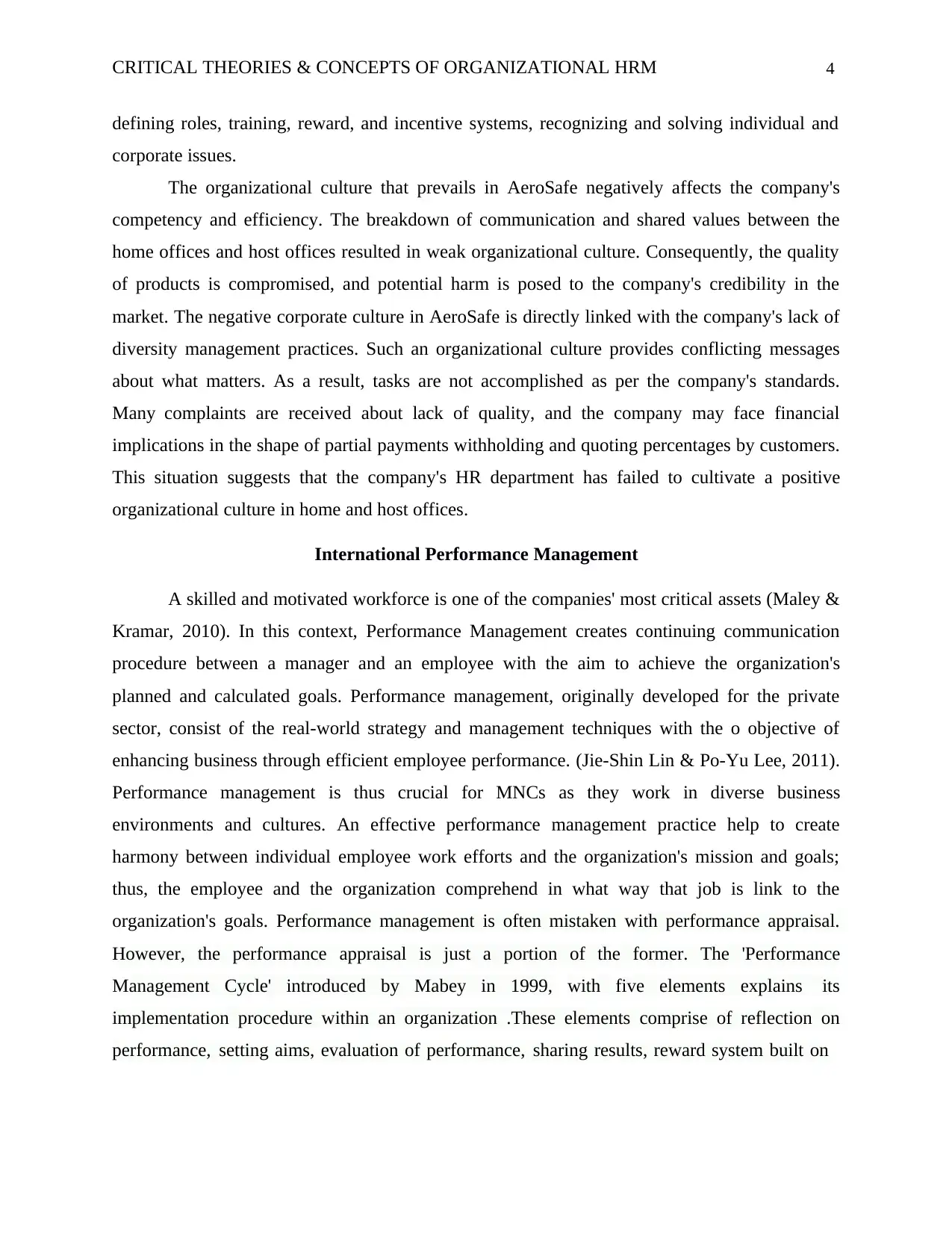
4CRITICAL THEORIES & CONCEPTS OF ORGANIZATIONAL HRM
defining roles, training, reward, and incentive systems, recognizing and solving individual and
corporate issues.
The organizational culture that prevails in AeroSafe negatively affects the company's
competency and efficiency. The breakdown of communication and shared values between the
home offices and host offices resulted in weak organizational culture. Consequently, the quality
of products is compromised, and potential harm is posed to the company's credibility in the
market. The negative corporate culture in AeroSafe is directly linked with the company's lack of
diversity management practices. Such an organizational culture provides conflicting messages
about what matters. As a result, tasks are not accomplished as per the company's standards.
Many complaints are received about lack of quality, and the company may face financial
implications in the shape of partial payments withholding and quoting percentages by customers.
This situation suggests that the company's HR department has failed to cultivate a positive
organizational culture in home and host offices.
International Performance Management
A skilled and motivated workforce is one of the companies' most critical assets (Maley &
Kramar, 2010). In this context, Performance Management creates continuing communication
procedure between a manager and an employee with the aim to achieve the organization's
planned and calculated goals. Performance management, originally developed for the private
sector, consist of the real-world strategy and management techniques with the o objective of
enhancing business through efficient employee performance. (Jie-Shin Lin & Po-Yu Lee, 2011).
Performance management is thus crucial for MNCs as they work in diverse business
environments and cultures. An effective performance management practice help to create
harmony between individual employee work efforts and the organization's mission and goals;
thus, the employee and the organization comprehend in what way that job is link to the
organization's goals. Performance management is often mistaken with performance appraisal.
However, the performance appraisal is just a portion of the former. The 'Performance
Management Cycle' introduced by Mabey in 1999, with five elements explains its
implementation procedure within an organization .These elements comprise of reflection on
performance, setting aims, evaluation of performance, sharing results, reward system built on
defining roles, training, reward, and incentive systems, recognizing and solving individual and
corporate issues.
The organizational culture that prevails in AeroSafe negatively affects the company's
competency and efficiency. The breakdown of communication and shared values between the
home offices and host offices resulted in weak organizational culture. Consequently, the quality
of products is compromised, and potential harm is posed to the company's credibility in the
market. The negative corporate culture in AeroSafe is directly linked with the company's lack of
diversity management practices. Such an organizational culture provides conflicting messages
about what matters. As a result, tasks are not accomplished as per the company's standards.
Many complaints are received about lack of quality, and the company may face financial
implications in the shape of partial payments withholding and quoting percentages by customers.
This situation suggests that the company's HR department has failed to cultivate a positive
organizational culture in home and host offices.
International Performance Management
A skilled and motivated workforce is one of the companies' most critical assets (Maley &
Kramar, 2010). In this context, Performance Management creates continuing communication
procedure between a manager and an employee with the aim to achieve the organization's
planned and calculated goals. Performance management, originally developed for the private
sector, consist of the real-world strategy and management techniques with the o objective of
enhancing business through efficient employee performance. (Jie-Shin Lin & Po-Yu Lee, 2011).
Performance management is thus crucial for MNCs as they work in diverse business
environments and cultures. An effective performance management practice help to create
harmony between individual employee work efforts and the organization's mission and goals;
thus, the employee and the organization comprehend in what way that job is link to the
organization's goals. Performance management is often mistaken with performance appraisal.
However, the performance appraisal is just a portion of the former. The 'Performance
Management Cycle' introduced by Mabey in 1999, with five elements explains its
implementation procedure within an organization .These elements comprise of reflection on
performance, setting aims, evaluation of performance, sharing results, reward system built on
⊘ This is a preview!⊘
Do you want full access?
Subscribe today to unlock all pages.

Trusted by 1+ million students worldwide
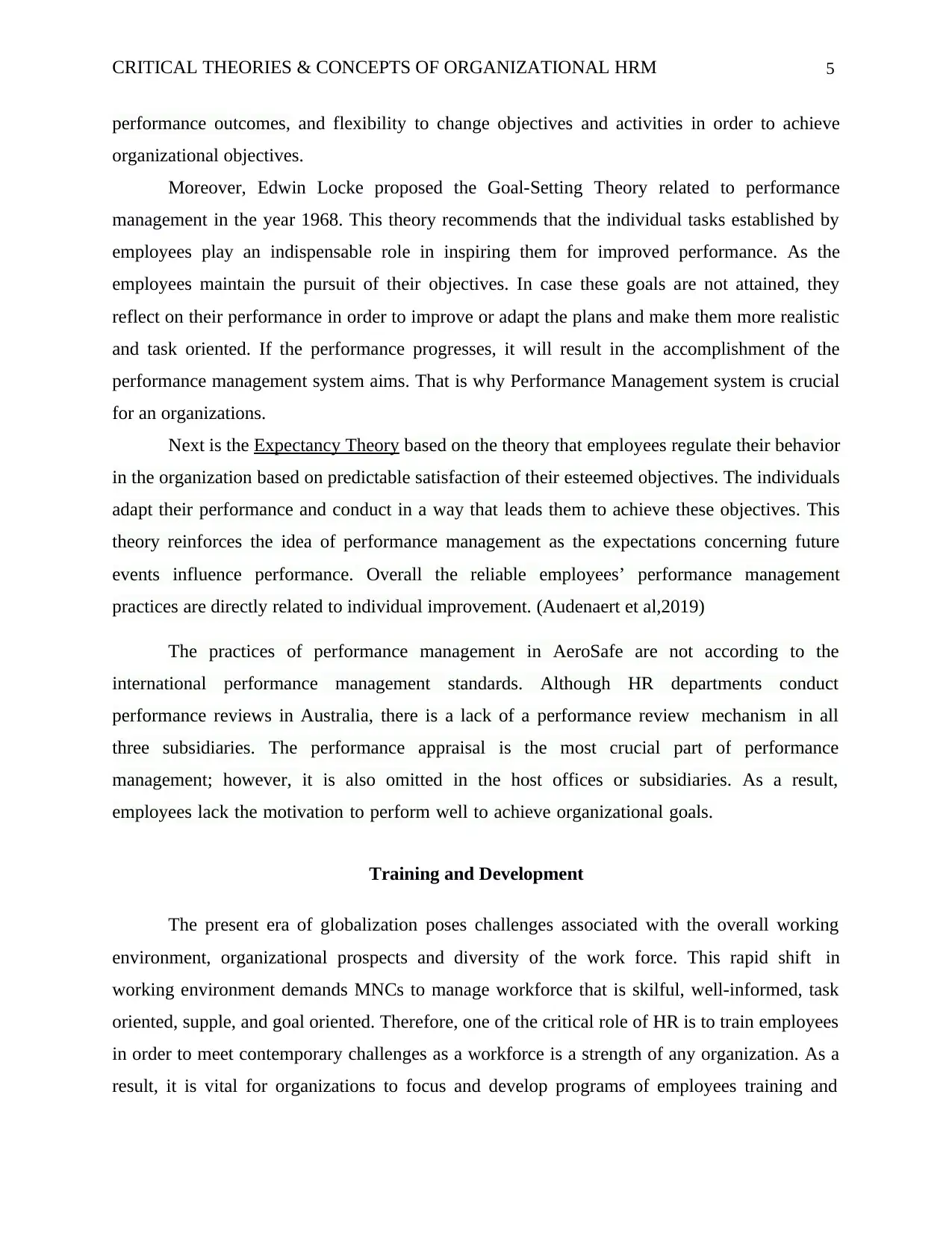
5CRITICAL THEORIES & CONCEPTS OF ORGANIZATIONAL HRM
performance outcomes, and flexibility to change objectives and activities in order to achieve
organizational objectives.
Moreover, Edwin Locke proposed the Goal-Setting Theory related to performance
management in the year 1968. This theory recommends that the individual tasks established by
employees play an indispensable role in inspiring them for improved performance. As the
employees maintain the pursuit of their objectives. In case these goals are not attained, they
reflect on their performance in order to improve or adapt the plans and make them more realistic
and task oriented. If the performance progresses, it will result in the accomplishment of the
performance management system aims. That is why Performance Management system is crucial
for an organizations.
Next is the Expectancy Theory based on the theory that employees regulate their behavior
in the organization based on predictable satisfaction of their esteemed objectives. The individuals
adapt their performance and conduct in a way that leads them to achieve these objectives. This
theory reinforces the idea of performance management as the expectations concerning future
events influence performance. Overall the reliable employees’ performance management
practices are directly related to individual improvement. (Audenaert et al,2019)
The practices of performance management in AeroSafe are not according to the
international performance management standards. Although HR departments conduct
performance reviews in Australia, there is a lack of a performance review mechanism in all
three subsidiaries. The performance appraisal is the most crucial part of performance
management; however, it is also omitted in the host offices or subsidiaries. As a result,
employees lack the motivation to perform well to achieve organizational goals.
Training and Development
The present era of globalization poses challenges associated with the overall working
environment, organizational prospects and diversity of the work force. This rapid shift in
working environment demands MNCs to manage workforce that is skilful, well-informed, task
oriented, supple, and goal oriented. Therefore, one of the critical role of HR is to train employees
in order to meet contemporary challenges as a workforce is a strength of any organization. As a
result, it is vital for organizations to focus and develop programs of employees training and
performance outcomes, and flexibility to change objectives and activities in order to achieve
organizational objectives.
Moreover, Edwin Locke proposed the Goal-Setting Theory related to performance
management in the year 1968. This theory recommends that the individual tasks established by
employees play an indispensable role in inspiring them for improved performance. As the
employees maintain the pursuit of their objectives. In case these goals are not attained, they
reflect on their performance in order to improve or adapt the plans and make them more realistic
and task oriented. If the performance progresses, it will result in the accomplishment of the
performance management system aims. That is why Performance Management system is crucial
for an organizations.
Next is the Expectancy Theory based on the theory that employees regulate their behavior
in the organization based on predictable satisfaction of their esteemed objectives. The individuals
adapt their performance and conduct in a way that leads them to achieve these objectives. This
theory reinforces the idea of performance management as the expectations concerning future
events influence performance. Overall the reliable employees’ performance management
practices are directly related to individual improvement. (Audenaert et al,2019)
The practices of performance management in AeroSafe are not according to the
international performance management standards. Although HR departments conduct
performance reviews in Australia, there is a lack of a performance review mechanism in all
three subsidiaries. The performance appraisal is the most crucial part of performance
management; however, it is also omitted in the host offices or subsidiaries. As a result,
employees lack the motivation to perform well to achieve organizational goals.
Training and Development
The present era of globalization poses challenges associated with the overall working
environment, organizational prospects and diversity of the work force. This rapid shift in
working environment demands MNCs to manage workforce that is skilful, well-informed, task
oriented, supple, and goal oriented. Therefore, one of the critical role of HR is to train employees
in order to meet contemporary challenges as a workforce is a strength of any organization. As a
result, it is vital for organizations to focus and develop programs of employees training and
Paraphrase This Document
Need a fresh take? Get an instant paraphrase of this document with our AI Paraphraser

6CRITICAL THEORIES & CONCEPTS OF ORGANIZATIONAL HRM
development to improve their competency and credibility. Such programs related to employees
training and growth must be focused on cumulative and updating workforce’ skills, knowledge,
capabilities, and understandings.(Obeidat & Abdallah, 2014). It is crucial for organizations to
prepare employees with the essential abilities and aptitudes to increase organizational
productivity, effectiveness, and performance in today's competitive environment (Kadiresan,
Selamat, Selladurai, Ramendran & Mohamed, 2015). Overall, it can be affirmed that HRM
practices serve as a tool employed by organizations to stimulate and create long term relationship
with employees through effective policy, procedures and organizational philosophy. (Singh &
Jain, 2014). Thus, by this way HRM will be able to obtain and sustain competent employees.
This will help the organizations to improve the performance of employees, and manage diversity
in organization and efficiently address the emotional and societal needs. As a result long term
commitment among employees can be established that will help to maintain an employment
relationship with the organization. The relationship between HR practices and organizational
commitment using different HR practices is one of the important topic of the modern research
study in the field of Management Sciences. Jeet and Sayeeduzzafar (2014) calculated five HR
practices that positively affect the employee relation with organization are professional training,
performance assessment and judgement, collaboration, employee contribution, and reward..
Similarly, Bal, Bozkurt, and Ertemsir (2014) have also recommended six HR practices: staffing
and selection, professional training and growth, performance review, work environment,
rewards, and participation of employees. Similarly, job design and employee empowerment are
also positively associated with organizational commitment.
The Training and development aspect of HRM in AeroSafe presents a lack of planning
and monitoring. There is lack of methodology and consolidated framework about how to plan
and conduct training programs that can build the professional capacity of AeroSafe employees.
Training programs are designed without prior assessment and evaluation of employees'
individual needs, and culture prevails in subsidiaries. This is evident from the fact that training
for those employees who leave Australia to work in China, Singapore, or Vietnam was
inadequate. HR department thus erroneously assumes that every person has the exact needs when
they agree to work in another country. As a result, expatriates faced a lack of integration in the
new workplace. Hence, the overall performance of the employees and company suffer.
development to improve their competency and credibility. Such programs related to employees
training and growth must be focused on cumulative and updating workforce’ skills, knowledge,
capabilities, and understandings.(Obeidat & Abdallah, 2014). It is crucial for organizations to
prepare employees with the essential abilities and aptitudes to increase organizational
productivity, effectiveness, and performance in today's competitive environment (Kadiresan,
Selamat, Selladurai, Ramendran & Mohamed, 2015). Overall, it can be affirmed that HRM
practices serve as a tool employed by organizations to stimulate and create long term relationship
with employees through effective policy, procedures and organizational philosophy. (Singh &
Jain, 2014). Thus, by this way HRM will be able to obtain and sustain competent employees.
This will help the organizations to improve the performance of employees, and manage diversity
in organization and efficiently address the emotional and societal needs. As a result long term
commitment among employees can be established that will help to maintain an employment
relationship with the organization. The relationship between HR practices and organizational
commitment using different HR practices is one of the important topic of the modern research
study in the field of Management Sciences. Jeet and Sayeeduzzafar (2014) calculated five HR
practices that positively affect the employee relation with organization are professional training,
performance assessment and judgement, collaboration, employee contribution, and reward..
Similarly, Bal, Bozkurt, and Ertemsir (2014) have also recommended six HR practices: staffing
and selection, professional training and growth, performance review, work environment,
rewards, and participation of employees. Similarly, job design and employee empowerment are
also positively associated with organizational commitment.
The Training and development aspect of HRM in AeroSafe presents a lack of planning
and monitoring. There is lack of methodology and consolidated framework about how to plan
and conduct training programs that can build the professional capacity of AeroSafe employees.
Training programs are designed without prior assessment and evaluation of employees'
individual needs, and culture prevails in subsidiaries. This is evident from the fact that training
for those employees who leave Australia to work in China, Singapore, or Vietnam was
inadequate. HR department thus erroneously assumes that every person has the exact needs when
they agree to work in another country. As a result, expatriates faced a lack of integration in the
new workplace. Hence, the overall performance of the employees and company suffer.
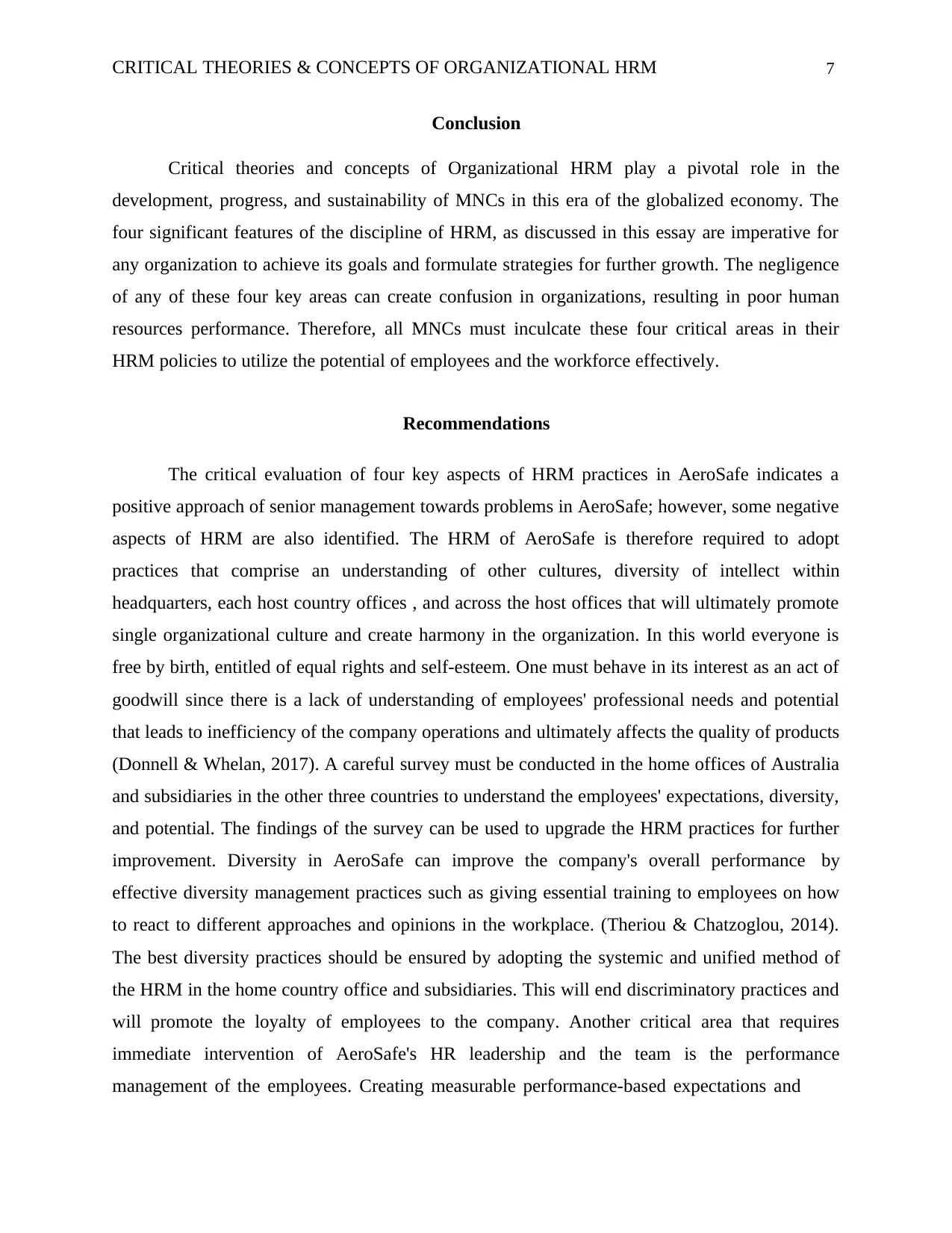
7CRITICAL THEORIES & CONCEPTS OF ORGANIZATIONAL HRM
Conclusion
Critical theories and concepts of Organizational HRM play a pivotal role in the
development, progress, and sustainability of MNCs in this era of the globalized economy. The
four significant features of the discipline of HRM, as discussed in this essay are imperative for
any organization to achieve its goals and formulate strategies for further growth. The negligence
of any of these four key areas can create confusion in organizations, resulting in poor human
resources performance. Therefore, all MNCs must inculcate these four critical areas in their
HRM policies to utilize the potential of employees and the workforce effectively.
Recommendations
The critical evaluation of four key aspects of HRM practices in AeroSafe indicates a
positive approach of senior management towards problems in AeroSafe; however, some negative
aspects of HRM are also identified. The HRM of AeroSafe is therefore required to adopt
practices that comprise an understanding of other cultures, diversity of intellect within
headquarters, each host country offices , and across the host offices that will ultimately promote
single organizational culture and create harmony in the organization. In this world everyone is
free by birth, entitled of equal rights and self-esteem. One must behave in its interest as an act of
goodwill since there is a lack of understanding of employees' professional needs and potential
that leads to inefficiency of the company operations and ultimately affects the quality of products
(Donnell & Whelan, 2017). A careful survey must be conducted in the home offices of Australia
and subsidiaries in the other three countries to understand the employees' expectations, diversity,
and potential. The findings of the survey can be used to upgrade the HRM practices for further
improvement. Diversity in AeroSafe can improve the company's overall performance by
effective diversity management practices such as giving essential training to employees on how
to react to different approaches and opinions in the workplace. (Theriou & Chatzoglou, 2014).
The best diversity practices should be ensured by adopting the systemic and unified method of
the HRM in the home country office and subsidiaries. This will end discriminatory practices and
will promote the loyalty of employees to the company. Another critical area that requires
immediate intervention of AeroSafe's HR leadership and the team is the performance
management of the employees. Creating measurable performance-based expectations and
Conclusion
Critical theories and concepts of Organizational HRM play a pivotal role in the
development, progress, and sustainability of MNCs in this era of the globalized economy. The
four significant features of the discipline of HRM, as discussed in this essay are imperative for
any organization to achieve its goals and formulate strategies for further growth. The negligence
of any of these four key areas can create confusion in organizations, resulting in poor human
resources performance. Therefore, all MNCs must inculcate these four critical areas in their
HRM policies to utilize the potential of employees and the workforce effectively.
Recommendations
The critical evaluation of four key aspects of HRM practices in AeroSafe indicates a
positive approach of senior management towards problems in AeroSafe; however, some negative
aspects of HRM are also identified. The HRM of AeroSafe is therefore required to adopt
practices that comprise an understanding of other cultures, diversity of intellect within
headquarters, each host country offices , and across the host offices that will ultimately promote
single organizational culture and create harmony in the organization. In this world everyone is
free by birth, entitled of equal rights and self-esteem. One must behave in its interest as an act of
goodwill since there is a lack of understanding of employees' professional needs and potential
that leads to inefficiency of the company operations and ultimately affects the quality of products
(Donnell & Whelan, 2017). A careful survey must be conducted in the home offices of Australia
and subsidiaries in the other three countries to understand the employees' expectations, diversity,
and potential. The findings of the survey can be used to upgrade the HRM practices for further
improvement. Diversity in AeroSafe can improve the company's overall performance by
effective diversity management practices such as giving essential training to employees on how
to react to different approaches and opinions in the workplace. (Theriou & Chatzoglou, 2014).
The best diversity practices should be ensured by adopting the systemic and unified method of
the HRM in the home country office and subsidiaries. This will end discriminatory practices and
will promote the loyalty of employees to the company. Another critical area that requires
immediate intervention of AeroSafe's HR leadership and the team is the performance
management of the employees. Creating measurable performance-based expectations and
⊘ This is a preview!⊘
Do you want full access?
Subscribe today to unlock all pages.

Trusted by 1+ million students worldwide
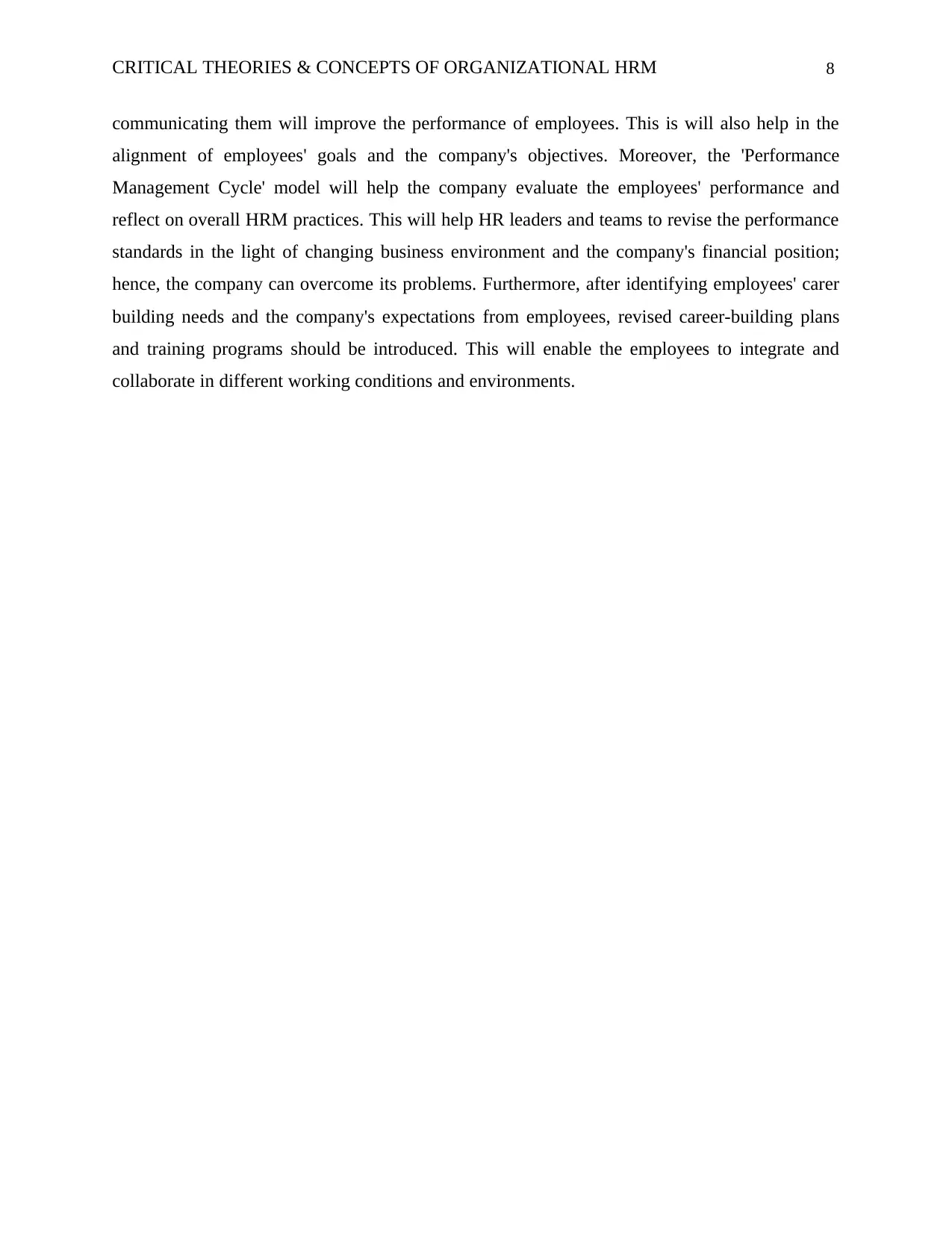
8CRITICAL THEORIES & CONCEPTS OF ORGANIZATIONAL HRM
communicating them will improve the performance of employees. This is will also help in the
alignment of employees' goals and the company's objectives. Moreover, the 'Performance
Management Cycle' model will help the company evaluate the employees' performance and
reflect on overall HRM practices. This will help HR leaders and teams to revise the performance
standards in the light of changing business environment and the company's financial position;
hence, the company can overcome its problems. Furthermore, after identifying employees' carer
building needs and the company's expectations from employees, revised career-building plans
and training programs should be introduced. This will enable the employees to integrate and
collaborate in different working conditions and environments.
communicating them will improve the performance of employees. This is will also help in the
alignment of employees' goals and the company's objectives. Moreover, the 'Performance
Management Cycle' model will help the company evaluate the employees' performance and
reflect on overall HRM practices. This will help HR leaders and teams to revise the performance
standards in the light of changing business environment and the company's financial position;
hence, the company can overcome its problems. Furthermore, after identifying employees' carer
building needs and the company's expectations from employees, revised career-building plans
and training programs should be introduced. This will enable the employees to integrate and
collaborate in different working conditions and environments.
Paraphrase This Document
Need a fresh take? Get an instant paraphrase of this document with our AI Paraphraser
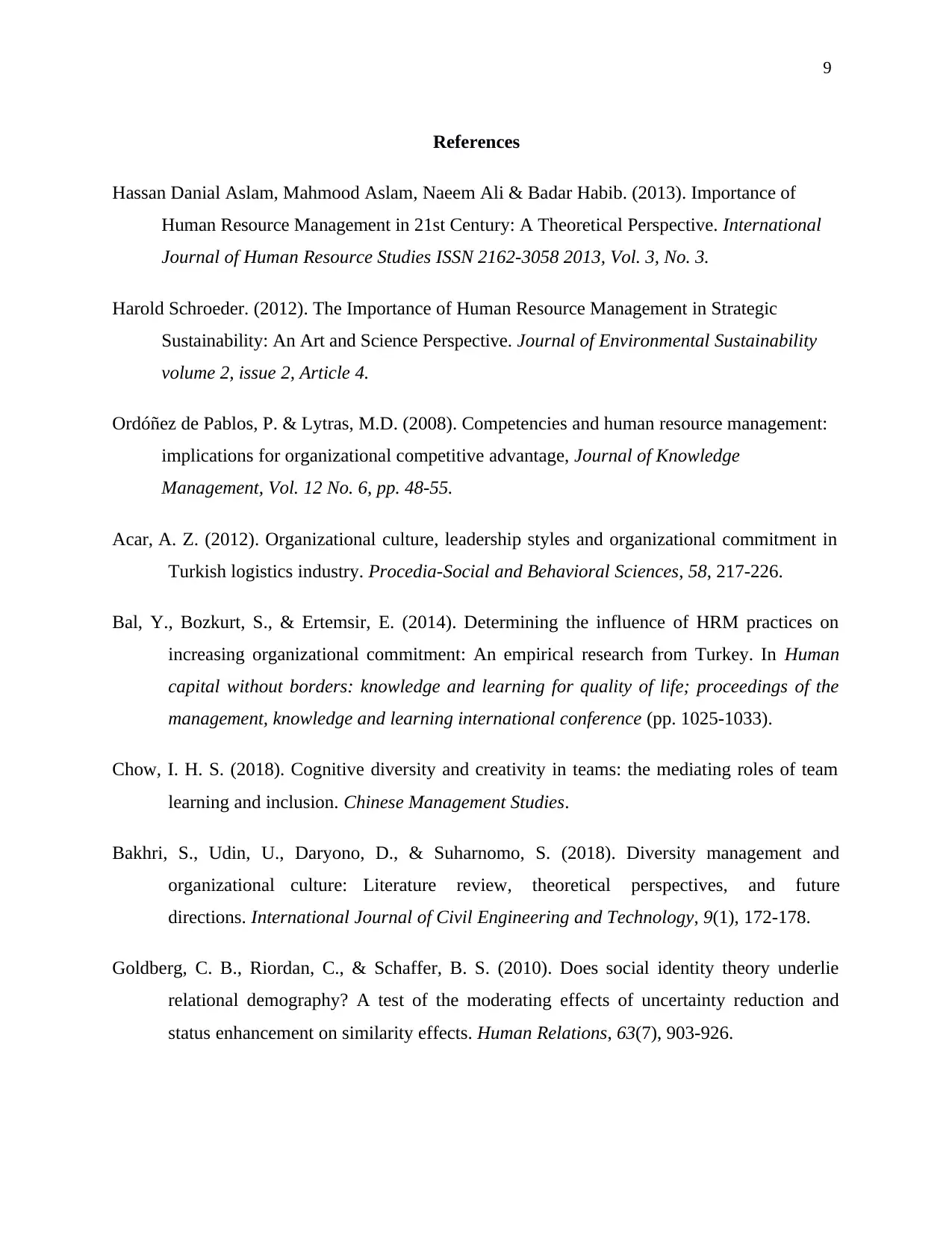
9
References
Hassan Danial Aslam, Mahmood Aslam, Naeem Ali & Badar Habib. (2013). Importance of
Human Resource Management in 21st Century: A Theoretical Perspective. International
Journal of Human Resource Studies ISSN 2162-3058 2013, Vol. 3, No. 3.
Harold Schroeder. (2012). The Importance of Human Resource Management in Strategic
Sustainability: An Art and Science Perspective. Journal of Environmental Sustainability
volume 2, issue 2, Article 4.
Ordóñez de Pablos, P. & Lytras, M.D. (2008). Competencies and human resource management:
implications for organizational competitive advantage, Journal of Knowledge
Management, Vol. 12 No. 6, pp. 48-55.
Acar, A. Z. (2012). Organizational culture, leadership styles and organizational commitment in
Turkish logistics industry. Procedia-Social and Behavioral Sciences, 58, 217-226.
Bal, Y., Bozkurt, S., & Ertemsir, E. (2014). Determining the influence of HRM practices on
increasing organizational commitment: An empirical research from Turkey. In Human
capital without borders: knowledge and learning for quality of life; proceedings of the
management, knowledge and learning international conference (pp. 1025-1033).
Chow, I. H. S. (2018). Cognitive diversity and creativity in teams: the mediating roles of team
learning and inclusion. Chinese Management Studies.
Bakhri, S., Udin, U., Daryono, D., & Suharnomo, S. (2018). Diversity management and
organizational culture: Literature review, theoretical perspectives, and future
directions. International Journal of Civil Engineering and Technology, 9(1), 172-178.
Goldberg, C. B., Riordan, C., & Schaffer, B. S. (2010). Does social identity theory underlie
relational demography? A test of the moderating effects of uncertainty reduction and
status enhancement on similarity effects. Human Relations, 63(7), 903-926.
References
Hassan Danial Aslam, Mahmood Aslam, Naeem Ali & Badar Habib. (2013). Importance of
Human Resource Management in 21st Century: A Theoretical Perspective. International
Journal of Human Resource Studies ISSN 2162-3058 2013, Vol. 3, No. 3.
Harold Schroeder. (2012). The Importance of Human Resource Management in Strategic
Sustainability: An Art and Science Perspective. Journal of Environmental Sustainability
volume 2, issue 2, Article 4.
Ordóñez de Pablos, P. & Lytras, M.D. (2008). Competencies and human resource management:
implications for organizational competitive advantage, Journal of Knowledge
Management, Vol. 12 No. 6, pp. 48-55.
Acar, A. Z. (2012). Organizational culture, leadership styles and organizational commitment in
Turkish logistics industry. Procedia-Social and Behavioral Sciences, 58, 217-226.
Bal, Y., Bozkurt, S., & Ertemsir, E. (2014). Determining the influence of HRM practices on
increasing organizational commitment: An empirical research from Turkey. In Human
capital without borders: knowledge and learning for quality of life; proceedings of the
management, knowledge and learning international conference (pp. 1025-1033).
Chow, I. H. S. (2018). Cognitive diversity and creativity in teams: the mediating roles of team
learning and inclusion. Chinese Management Studies.
Bakhri, S., Udin, U., Daryono, D., & Suharnomo, S. (2018). Diversity management and
organizational culture: Literature review, theoretical perspectives, and future
directions. International Journal of Civil Engineering and Technology, 9(1), 172-178.
Goldberg, C. B., Riordan, C., & Schaffer, B. S. (2010). Does social identity theory underlie
relational demography? A test of the moderating effects of uncertainty reduction and
status enhancement on similarity effects. Human Relations, 63(7), 903-926.
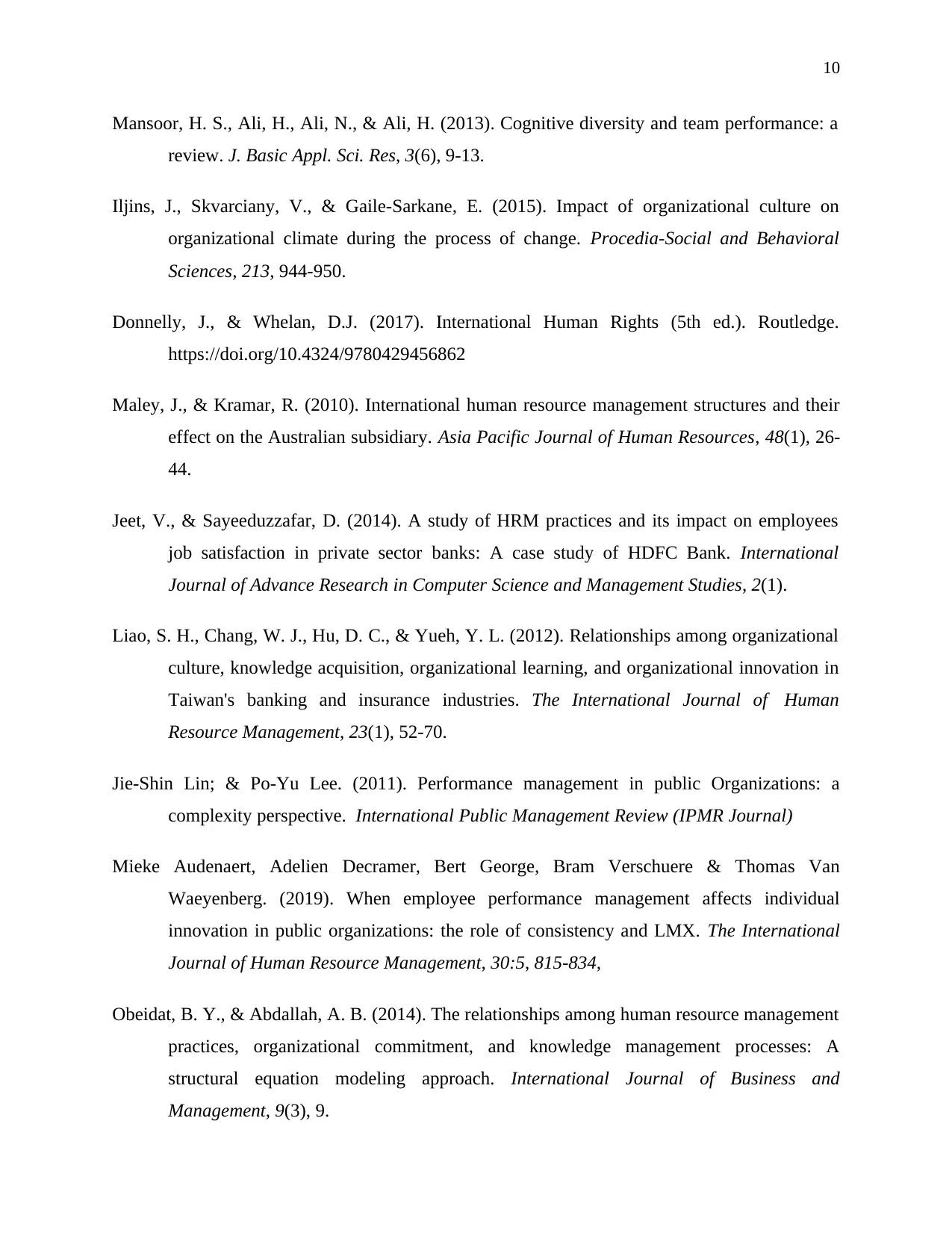
10
Mansoor, H. S., Ali, H., Ali, N., & Ali, H. (2013). Cognitive diversity and team performance: a
review. J. Basic Appl. Sci. Res, 3(6), 9-13.
Iljins, J., Skvarciany, V., & Gaile-Sarkane, E. (2015). Impact of organizational culture on
organizational climate during the process of change. Procedia-Social and Behavioral
Sciences, 213, 944-950.
Donnelly, J., & Whelan, D.J. (2017). International Human Rights (5th ed.). Routledge.
https://doi.org/10.4324/9780429456862
Maley, J., & Kramar, R. (2010). International human resource management structures and their
effect on the Australian subsidiary. Asia Pacific Journal of Human Resources, 48(1), 26-
44.
Jeet, V., & Sayeeduzzafar, D. (2014). A study of HRM practices and its impact on employees
job satisfaction in private sector banks: A case study of HDFC Bank. International
Journal of Advance Research in Computer Science and Management Studies, 2(1).
Liao, S. H., Chang, W. J., Hu, D. C., & Yueh, Y. L. (2012). Relationships among organizational
culture, knowledge acquisition, organizational learning, and organizational innovation in
Taiwan's banking and insurance industries. The International Journal of Human
Resource Management, 23(1), 52-70.
Jie-Shin Lin; & Po-Yu Lee. (2011). Performance management in public Organizations: a
complexity perspective. International Public Management Review (IPMR Journal)
Mieke Audenaert, Adelien Decramer, Bert George, Bram Verschuere & Thomas Van
Waeyenberg. (2019). When employee performance management affects individual
innovation in public organizations: the role of consistency and LMX. The International
Journal of Human Resource Management, 30:5, 815-834,
Obeidat, B. Y., & Abdallah, A. B. (2014). The relationships among human resource management
practices, organizational commitment, and knowledge management processes: A
structural equation modeling approach. International Journal of Business and
Management, 9(3), 9.
Mansoor, H. S., Ali, H., Ali, N., & Ali, H. (2013). Cognitive diversity and team performance: a
review. J. Basic Appl. Sci. Res, 3(6), 9-13.
Iljins, J., Skvarciany, V., & Gaile-Sarkane, E. (2015). Impact of organizational culture on
organizational climate during the process of change. Procedia-Social and Behavioral
Sciences, 213, 944-950.
Donnelly, J., & Whelan, D.J. (2017). International Human Rights (5th ed.). Routledge.
https://doi.org/10.4324/9780429456862
Maley, J., & Kramar, R. (2010). International human resource management structures and their
effect on the Australian subsidiary. Asia Pacific Journal of Human Resources, 48(1), 26-
44.
Jeet, V., & Sayeeduzzafar, D. (2014). A study of HRM practices and its impact on employees
job satisfaction in private sector banks: A case study of HDFC Bank. International
Journal of Advance Research in Computer Science and Management Studies, 2(1).
Liao, S. H., Chang, W. J., Hu, D. C., & Yueh, Y. L. (2012). Relationships among organizational
culture, knowledge acquisition, organizational learning, and organizational innovation in
Taiwan's banking and insurance industries. The International Journal of Human
Resource Management, 23(1), 52-70.
Jie-Shin Lin; & Po-Yu Lee. (2011). Performance management in public Organizations: a
complexity perspective. International Public Management Review (IPMR Journal)
Mieke Audenaert, Adelien Decramer, Bert George, Bram Verschuere & Thomas Van
Waeyenberg. (2019). When employee performance management affects individual
innovation in public organizations: the role of consistency and LMX. The International
Journal of Human Resource Management, 30:5, 815-834,
Obeidat, B. Y., & Abdallah, A. B. (2014). The relationships among human resource management
practices, organizational commitment, and knowledge management processes: A
structural equation modeling approach. International Journal of Business and
Management, 9(3), 9.
⊘ This is a preview!⊘
Do you want full access?
Subscribe today to unlock all pages.

Trusted by 1+ million students worldwide
1 out of 14
Related Documents
Your All-in-One AI-Powered Toolkit for Academic Success.
+13062052269
info@desklib.com
Available 24*7 on WhatsApp / Email
![[object Object]](/_next/static/media/star-bottom.7253800d.svg)
Unlock your academic potential
Copyright © 2020–2025 A2Z Services. All Rights Reserved. Developed and managed by ZUCOL.




